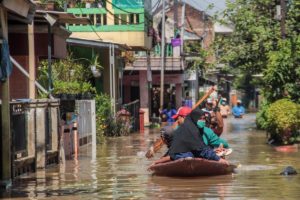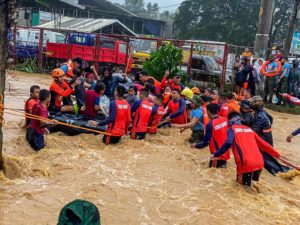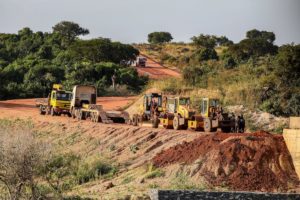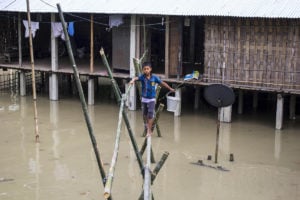The mountain of science examining climate change continues to grow rapidly, and evidence of its real-world impacts is becoming ever more apparent.
In March, the latest IPCC (Intergovernmental Panel on Climate Change) report warned of dramatic changes impacting human health, natural ecosystems and global and local economies.
But even as determined measures to mitigate and adapt to climate change become more urgent, significant geographical gaps remain in the research underlying these assessments.
Research gaps
A recent study published in the journal Environmental Research: Climate reveals a pressing need for more information. It found that, while the growing field of attribution science has led to major advances in linking extreme weather with human-induced climate change, there are big differences in the understanding of the impacts on different regions and countries.
One of the report’s authors is Dr Luke Harrington, a senior lecturer at the University of Waikato. At a press conference on the paper, he said many parts of the world do not have long enough historical records or sufficient high-quality data to predict the kinds and severity of extreme weather events they will endure. For example, there are practically no official records of heatwaves in sub-Saharan Africa, despite it being a “literal hotspot for heatwave activity”.
It is a problem recognised by Dr Caroline Wainwright, a Grantham Institute research fellow at Imperial College London who studies climate variability and change in tropical regions. She told China Dialogue that regions such as Europe have “definitely been studied more than places in Africa”, with the result that we do not have a full picture of what’s going on.
Namita Chakma, professor of geography at the University of Burdwan in India, agrees, saying there is a lack of scientific analysis on India due to the paucity of information collected daily from weather stations “and a lack of continuity in the long-term climatic data sets. It is also difficult to study climatic variables at the micro-regional level.”
In East Africa, there is huge uncertainty about whether the climate will get wetter or drier
Nor is there enough information to assess the total human and societal costs of extreme weather events. While some studies have looked at economic and infrastructure impacts, deaths and hospitalisations, these are generally limited to wealthier countries in the global north.
For example, Harrington refers to a global database that records mortality linked to extreme weather events; deaths recorded in Asia, Africa, South America and the Caribbean were only a small fraction despite those regions making up 85% of the world’s population. “Some parts of the world have much more robust monitoring systems in place to track the impacts of these types of events,” he said.
The result is a significant underestimate of the harms of climate change in lower- and middle-income countries.
Dr Friederike Otto, senior lecturer at the Grantham Institute and an expert in attribution science, also co-authored the Environmental Research: Climate study. She said at the press conference that not having this information denies countries the knowledge to plan appropriately, make the best use of limited resources and improve chances for people to live safely and adapt to the changing climate.
For example, Wainwright points out that in East Africa, there is huge uncertainty about whether the climate will get wetter or drier, which affects state and community planning.
Barriers to research
This problem has been bubbling under the surface of climate science for a few years.
Part of the issue is a paucity of published academic literature from outside the global north. When Reuters published a “hot list” of the thousand “most influential” climate academics in 2021, it sparked a backlash from researchers because it listed so few scientists from the global south.
However, research by Carbon Brief into the backgrounds of around 1,300 authors involved in the 100 most-cited climate change research papers from 2016 to 2020 found a similar pattern. It also discovered significant imbalances within regions; eight of the ten African authors were from South Africa. And when it came to lead authors, not one of the top 100 papers was led by a scientist from Africa or South America. Of the seven papers led by Asian authors, five were from China.
Language can be a barrier, as can local research capacity.
A 2018 paper published in Nature Climate Change, which examined the obstacles facing Africa’s young climate scientists, found that inadequate facilities, underfunded research, inaccessible data and undeveloped academic writing skills undermined efforts to combat climate change on the continent.
Dr Victor Dike, a researcher at the Chinese Academy of Sciences’ Institute of Atmospheric Physics who specialises in extreme weather events in Africa and East Asia, said researchers in Africa may not have time or funding available to publish papers in the highest profile journals and do not always have the resources to be up to date with the latest science and policy. “It would be difficult for someone to make a significant contribution in that respect.”
Dike notes that researchers in China are incentivised to publish in high-impact journals with cash bonuses from their institutions.
Wainwright also highlights limitations in short- and long-term weather forecasting, saying this affects agriculture and day-to-day service planning. The Environmental Research: Climate paper points to examples in South Africa, where corruption denies funds to weather reporting facilities leading to massive data gaps in an otherwise good forecasting network, and drought-prone Somalia, where disorderly regime changes have disrupted data collection.
Furthermore, regions like East Africa have high natural variability, which makes studying changes in their climate difficult. And they may be affected by atmospheric phenomena like La Niña, which complicate climatic predictions.
Researchers say geographical gaps also stem from the fact that scientific efforts around the world are not valued equally, with research in the global south often aimed at solving highly local problems. Debra Roberts, acting head of the Sustainable and Resilient City Initiatives Unit in South Africa’s Ethekwini municipality, said much of the climate work being done at the city level is not written down. “Very often, a lot of that knowledge is in people’s heads.”
Even the IPCC is not truly representative. Roberts, who is also an honorary professor of life sciences at the University of KwaZulu-Natal and co-chair of the IPCC’s working group II, said there is a constant battle to ensure enough researchers from the global south are working on international reports. “We have improved with each assessment cycle, but it’s still something that needs real work; not only in getting people in the room but ensuring when they’re in the room that they’re heard.”
Technology can be both a climate science boon and another barrier.
Wainwright notes that most climate models have developed in the global north “and are therefore generally better at representing the climate in those regions”. Dike agrees. Having examined several different datasets, he does not think they fully capture the spatial distribution of rainfall or its variability over West Africa.
Most climate models have developed in the global north and are therefore generally better at representing the climate in those regions
Artificial intelligence is also a challenge. A paper exploring machine learning tools in the UK found they can support research on climate adaptation policy by quickly processing large volumes of policy text. But they only work with digitised data, “which in many parts of the world is a severe limitation”.
Programmes are attempting to build climate science capacity in the global south, including the UN World Meteorological Organization’s regional training centre in Nanjing and GCRF African Swift’s work funded by UK Research and Innovation, which aims to improve forecasting in Africa.
But there is still much work to be done.
Dike recently received a grant from the Chinese government to work in West Africa. He said such funding is necessary and welcome but also rare. He adds that funding bodies – government or companies – have their own strategic or commercial interests that do not necessarily align with research gaps or the needs of local communities. “They want to solve their own problems.”
He would like a general improvement in the quality of research in Africa and sees mentorship and training as a means to address this. Collaboration is also critical, he said, to assist researchers in reading papers and working with datasets they might not otherwise have access to.
Dike talks wistfully of returning to work in Nigeria. “When I was doing my PhD, I had this burning zeal to go back to Africa to contribute to science. But when you get there, you may not be able to publish your good manuscript. There are a lot of problems facing scientists in Africa.”








